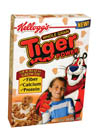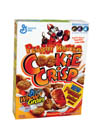
Kellogg joined the whole-grain parade by launching Tiger Power Whole Grain Cereal. While its packaging did not boast the whole-grain claim, it did tout the presence of fiber (for proper digestion), calcium (for strong bones and teeth) and protein (for muscle development)—three ingredients “Gr-r-reat for GROWTH!” according to the package.
Kellogg's whole-grain efforts followed on the heels of General Mills' 2004 conversion of all of its Big G cereals to whole-grain versions. The entire Big G cereal portfolio is now a “good” or “excellent” source of whole grain, the former providing at least 8g per serving, with the latter offering at least 16g. Two of those brands (Total and Wheaties) were among the company's long-time whole-grain cereals that had no change, yet they did see some noteworthy applications this year.
Both Total and Wheaties are well-known among consumers, having been around for over 40 and 80 years, respectively, but thanks to a General Mills partnership with Leiner Health Products, they found their way into the dietary supplement aisles. Similar moves had been attempted by such diverse companies as Procter & Gamble and Prevention magazine, but General Mills found its dual-pronged move to be a “natural extension of the health promise of these brands.”
Each brand of supplements targeted a similar demographic. Wheaties sought active adults aged 25 to 44 with 100% or more of 17 vitamins and minerals, plus coenzyme Q10. Total, on the other hand, was for the over-35 consumer seeking to maintain a healthy lifestyle and improve energy levels, eye and cardiovascular health and bones. It featured 24 vitamins and minerals, in addition to lutein, lycopene and extra B vitamins.

For the Kids
General Mills also went beyond the whole-grain movement with a new television advertising initiative aimed at children. “Choose Breakfast” was the company's largest children's advertising effort ever, in terms of number of children reached. This non-branded approach sought to communicate the benefits of breakfast to young people, by showing children in fun settings with the health benefits of breakfast. It utilized such “kid terms” as “think fast,” “have power” and “get going.” According to a company spokesperson, the inspirational messages are “in line with how kids process communication around health benefits.”
This came amid studies touting the benefits of fish oil as a means of helping children perform better at school. While it might seem unusual to find a study on fish oil in a report on cereals, keep in mind that the delivery method was cereal bars. The experiment, performed over a 12-week period among four- to seven-year-olds, revealed that pupils' attention spans and abilities to focus showed “remarkable” improvement after eating one fish oil-supplemented bar a day.

Up to the Bar
The snack and energy bar segment did see some new entrants this year, as The Hershey Co. took a giant leap into the segment. First, the company introduced a line of Snack Barz and a PayDay High-protein Energy Bar. Shortly thereafter came a line of SmartZone Nutrition Bars. The latter, developed with the Zone Diet in mind, contained roughly 200 calories and had a balance of 40% carbohydrates, 30% fat and 30% protein. It was North America's first product to carry the “Dr. Sears Zone Approved” seal, bestowed by Zone Labs, founded by the inventor of the Zone Diet, Dr. Barry Sears.The bar segment also saw a variety of “low in...” claims. Launches carrying this positioning continued to grow throughout the year, with substantial growth among low-cholesterol, low-sodium, low-glycemic and low-trans fat items. The latter two were of particular interest, as both were fairly new responses to society's changing dietary trends.
Low-glycemic entries promised consumers a “safer” way to monitor carbohydrate intake. Namely, they do not remove them from the diet, but substitute carbohydrates with an immediate effect on blood glucose levels with those that slowly release energy; this limits feelings of hunger and prolongs physical endurance. Described as a healthy alternative to the net-carb approach, Solo Smart Carbohydrate Snack Bars were low-glycemic and contained only “good” carbohydrates, as well as 23 vitamins and minerals. From Solo GI Nutrition, they also lacked sugar alcohol and trans fats. Late in the year, Hershey added a low-glycemic version of SmartZone Crunch Energy Bars, and Living Fuel Rx launched CocoChia Ultimate Snack Fuel Bar, a low-glycemic raw food bar made with organic ingredients, including almonds, coconut and chia seeds. Free of trans fat, the Super Berry variety featured healthy fats and fiber, plus what was described as a “super berry antioxidant complex.”

The news of the year for the cereal segment also proved a favorite among bar introductions, as whole grains staked a place in this arena. Nabisco (Kraft) Fig Newtons Bars, for instance, were reformulated with 100% whole grain and received Kraft's “Sensible Snacking” designation. Nabisco products could qualify for the “Sensible Snacking” label in one of two ways (per serving). Option one is for the product to have either: no more than 100 calories; no more than 30% calories from fat and no more than 10% calories from saturated fat plus trans fat; no more than 290mg of sodium; no more than 25% calories from added sugar; or 10% or more of the Daily Value of vitamins A, C or E, calcium, magnesium, potassium iron, protein or fiber, or contain at least a half serving of fruit, vegetable or a nutritionally significant amount of whole grain or have a functional nutrition benefit. The second option demands that the product must be free of or low in calories, fat, saturated fat, sugar or sodium, or must have 25% less of one of these in comparison to the base product or an appropriate reference product, and must be reviewed by the company's nutrition department.
Bring on the Function
The U.S. has yet to see a surge in functional snack bars, though a few have made their way stateside. General Mills' Nature Valley brand of chewy granola bars added a Healthy Heart variety, promising to help lower cholesterol, while Masterfoods repackaged its Cocoa Via crunch bars and launched four new products under the line: chocolate-covered almonds and three chocolate bars formulated to reduce bad cholesterol and promote healthy circulation. Available in original chocolate, crispy, and blueberry and almond, the bars targeted consumers who loved chocolate and cared about their health, but each bar had a seal also touting that a single bar has 100 calories, thereby attracting the calorie-conscious consumer as well.Nonetheless, the U.S. functional bar sector has room to grow, as evidenced by a couple of U.K. introductions. Burton's Foods' Fruvo Natural Energy Bars are available in four beneficial varieties: Immune Boost (with echinacea, vitamin C and zinc); Physical Energy (promising an energy boost for up to two hours); Mental Energy (for well-being and alertness); and Prebiotic Boost (supposedly aiding the growth of beneficial bacteria). Also in the U.K., The Food Doctor promises a stress-reducing benefit with the addition of the herb chamomile, known for its relaxing properties, in Unwind Fruit & Seed Bar.
While health would appear secondary for some brands, even the more-indulgent lines managed to boast of some healthfulness. General Mills, for instance, added a new variant to its Cookie Crisp cereal. Peanut Butter Cookie Crisp sought to combine the taste of peanut butter, cookies and milk. Another of the General Mills products boasting whole grain, it added 12 vitamins and minerals, while also serving as a good source of calcium.
Furthermore, considering the Centers for Disease Control National Center for Health Statistics found some 105 million American adults with higher total blood cholesterol levels than recommended, Quaker sought about helping to rectify those at serious risk of heart disease. Take Heart Instant Oatmeal was designed for heart health, promising 50% more soluble fiber from whole-grain oats to help lower cholesterol, as well as enough potassium to lower the risk of high blood pressure.
Considering the already-healthful connotations associated with breakfast and many cereals in general, particularly oatmeal and whole-grain cereals, the segment is poised to reap a harvest among more nutritionally aware consumers. The challenge will be finding the proper avenue to reach those consumers.
Much of the information in this article was derived from Mintel International's Global New Products Database, www.gnpd.com, 312-932-0400.
Sidebar: Going Global
While the revamped dietary guidelines did much for whole grains in the U.S., their healthful message is out around the world, and consumers worldwide are embracing whole grains' bowel and heart benefits. In Germany, Kellogg's DayVita were high-fiber, whole-grain cereals clearly identifying the amount of fiber on the package. Basic had wholemeal flakes and dried fruit, promising 9% fiber, while Medium's 12% fiber was from wholemeal flakes alone. Forte (strong), meanwhile, had wholemeal sticks and a powerful 22% fiber; that is, 22g of fiber per 100g serving.Whole grains also factored in Kellogg's Toppas in the Czech Republic. This whole-grain cereal was enriched with vitamins and minerals, while being low in fat and good for the heart. Not to be outdone on the whole-grain front, Kraft's Post brand in Canada added Post Wholesome Classics Spoon Size Shredded Wheat 100% Whole Grain Wheat cereal, containing 4g of fiber per 2/3 cup (30g).
Kellogg's was not solely focused on whole grains, however. In the U.K., the company retooled Rice Krispies Muddles as Rice Krispies Multi-grain, which were reformulated with natural prebiotics to “keep tummies healthy” and enriched with iron, calcium and vitamins.
Providing some gut health benefits to Spanish consumers, Biocentury formulated Bio Century Linea with bifidus, to balance intestinal flora, and Belgo & Bellas introduced Canadian shoppers to Yog Active, a whole-grain cereal with 17% Lactobacillus acidophilus active yogurt pearls. Meanwhile, German consumers saw Hipp add a strawberry & raspberry variety of Hippness Crisp wheat cereals, formulated with prebiotics for digestive health.
